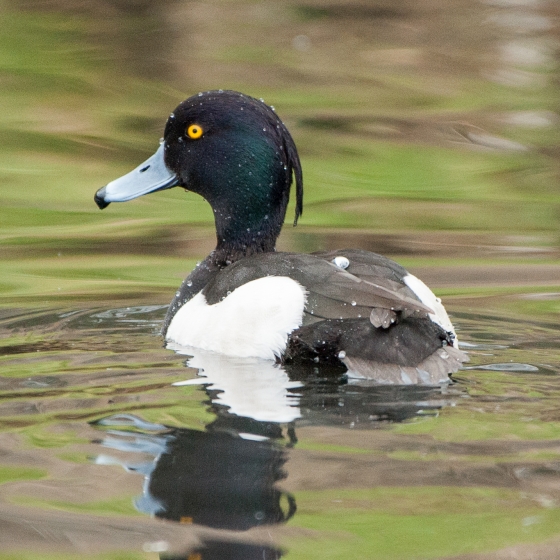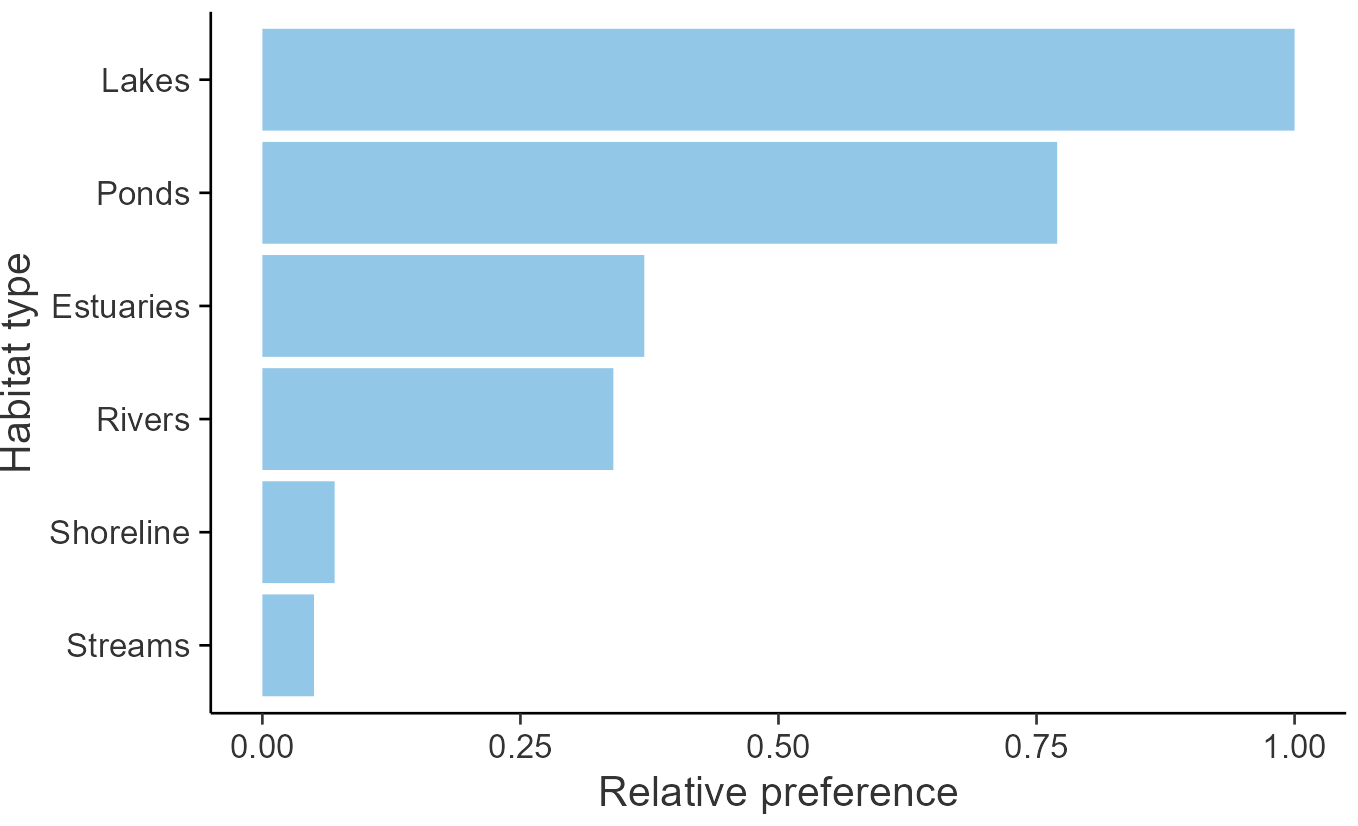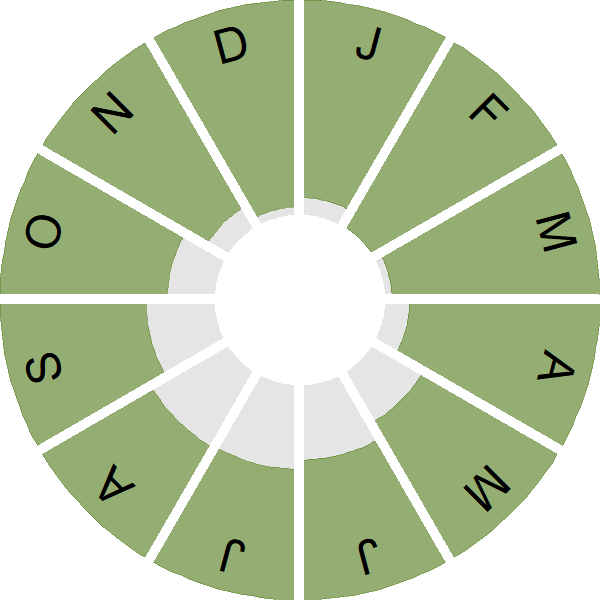Tufted Duck

Introduction
Tufted Ducks, the male black-and-white and the female buff-brown, both with a characteristic 'tuft', can be seen diving on waterbodies across Britain & Ireland.
The UK has a small breeding population of around 18,000 pairs, but during the winter months these are joined by over 100,000 birds from as far away as central Russia. Wetland Bird Survey data show that Loch Leven and Loughs Neagh and Beg, in Scotland and Ireland respectively, regularly hold almost 10,000 Tufted Ducks each during the winter.
These characterful little ducks can also be found on lakes and ponds in the middle of our busiest towns and cities, where they can be observed diving for their favoured food of aquatic invertebrates and bivalve molluscs.
- Our Trends Explorer gives you the latest insight into how this species' population is changing.

Key Stats
Identification
ID Videos
This section features BTO training videos headlining this species, or featuring it as a potential confusion species.
Diving Ducks
Songs and Calls
Call:
Flight call:
Status and Trends
Conservation Status
Population Change
The colonisation of the UK by Tufted Ducks, which began in 1849, was aided by the spread of the zebra mussel Dreissena polymorpha, a non-native invasive species that had been introduced accidentally to Britain a few decades earlier. The long-term increase shown by WBS/WBBS, and the increase in range in Britain between the three atlas periods (Gibbons et al. 1993, Balmer et al. 2013) indicated that population expansion and in-filling of range were still occurring until at least the early 2000s, although WBS/WBBS data since around 2010 suggest a recent downturn, and the long-term data suggest breeding numbers are now similar to the mid-1970s. However, this recent trend contrasts with BBS data which show stability or perhaps an increase since 1994 in the UK as a whole. The species' winter trend in the UK since the 1960s, which includes many continental visitors, is also shallowly upward, but with little recent change (WeBS: Frost et al. 2020).
Moderate recent declines elsewhere in northern Europe resulted in a period on the amber list in the UK from 2009-15, but the species is now green listed once more (Eaton et al. 2015). In Finland, there was a highly significant difference between stable trends in oligotrophic wetlands and declines in eutrophic wetlands from 1986 to 2013 (WeBS: Lehikoinen et al. 2016).
Distribution
The Tufted Duck is widespread in much of Britain during winter.
Occupied 10-km squares in UK
2007/08–10/11
or view it on Bird Atlas Mapstore.
2008–11
or view it on Bird Atlas Mapstore.
European Distribution Map
Distribution Change
Increases in breeding range are most noticeable along the northern and western margins of the 1968–72 range in Britain, with much infilling elsewhere.
Change in occupied 10-km squares in the UK
from 1981–84 to 2007–11
or view it on Bird Atlas Mapstore.
from 1968–72 to 2008–11
or view it on Bird Atlas Mapstore.
Seasonality
Tufted Ducks are present year-round.
Weekly pattern of occurrence
The graph shows when the species is present in the UK, with taller bars indicating a higher likelihood of encountering the species in appropriate regions and habitats.

Habitats
Breeding season habitats
Relative frequency by habitat
The graph shows the habitats occupied in the breeding season, with the most utilised habitats shown at the top. Bars of similar size indicate the species is equally likely to be recorded in those habitats.

Movement
Britain & Ireland movement
Foreign locations of birds ringed or recovered in Britain & Ireland
Dots show the foreign destinations of birds ringed in Britain & Ireland, and the origins of birds ringed overseas that were subsequently recaptured, resighted or found dead in Britain & Ireland. Dot colours indicate the time of year that the species was present at the location.
- Winter (Nov-Feb)
- Spring (Mar-Apr)
- Summer (May-Jul)
- Autumn (Aug-Oct)

European movements
EuroBirdPortal uses birdwatcher's records, such as those logged in BirdTrack to map the flows of birds as they arrive and depart Europe. See maps for this species here.
The Eurasian-African Migration Atlas shows movements of individual birds ringed or recovered in Europe. See maps for this species here.
Biology
Productivity and Nesting
Nesting timing
Egg measurements
Clutch Size
Survival and Longevity
Survival is shown as the proportion of birds surviving from one year to the next and is derived from bird ringing data. It can also be used to estimate how long birds typically live.
View number ringed each year in the Online Ringing Report.
Lifespan
Survival of adults
Survival of juveniles
Biometrics
Wing length and body weights are from live birds (source).
Wing length
Body weight
Ring Size
Classification, names and codes
Classification and Codes
- Order: Anseriformes
- Family: Anatidae
- Scientific name: Aythya fuligula
- Authority: Linnaeus, 1758
- BTO 2-letter code: TU
- BTO 5-letter code: TUFDU
- Euring code number: 2030
Alternate species names
- Catalan: morell de plomall
- Czech: polák chocholacka
- Danish: Troldand
- Dutch: Kuifeend
- Estonian: tuttvart
- Finnish: tukkasotka
- French: Fuligule morillon
- Gaelic: Lach-sgumanach
- German: Reiherente
- Hungarian: kontyos réce
- Icelandic: Skúfönd
- Irish: Lacha Bhadánach
- Italian: Moretta
- Latvian: cekulpile
- Lithuanian: kuoduotoji antis
- Norwegian: Toppand
- Polish: czernica
- Portuguese: negrinha
- Slovak: chochlacka vrkocatá
- Slovenian: copasta crnica
- Spanish: Porrón moñudo
- Swedish: vigg
- Welsh: Hwyaden Gopog
Research
Causes of Change and Solutions
Causes of change
There is little good evidence available regarding the drivers of the breeding population increase in this species in the UK.
Further information on causes of change
No further information is available.
Information about conservation actions
Like other wildfowl, this species may benefit from the continuation of recent local management actions and wider policies which help to improve water quality and increase the availability of wetland habitats.
More specifically, action to remove fish populations from gravel pits and other lakes may help improve breeding productivity for this species, by removing the competition from the fish which reduces the amount of invertebrate prey available to ducklings and adults (Giles 1994).
More Evidence
More evidence from Conservation Evidence.com
Partners
Citing BirdFacts
If you wish to cite particular content in this page (e.g. a specific value) it is best to use the original sources as linked in the page. For a more general citation of the whole page please use: BTO (20XX) BirdFacts Species: profiles of birds occurring in the United Kingdom. BTO, Thetford (www.bto.org/birdfacts, accessed on xx/xx/xxxx).

